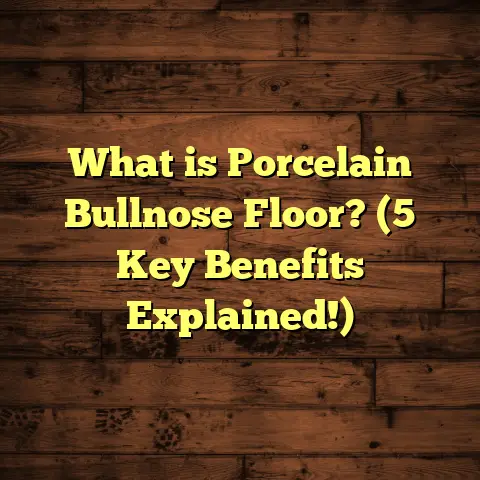What is California Hardwood Floor Life Expectancy? (5 Tips Inside!)
Upgrading your lifestyle often means upgrading your home,
and for me, that started with my floors. Hardwood floors
have this timeless charm that instantly makes a space feel
warmer and more inviting. But when I started exploring
hardwood flooring options in California, one question kept
popping up: How long will these floors actually last?
I want to share everything I’ve learned about California
hardwood floor life expectancy, including some tips I picked
up along the way. Whether you’re thinking about installing
hardwood floors or just curious about how long they hold up
in this unique environment, this will give you a clear picture.
What Is California Hardwood Floor Life Expectancy?
When I say “California hardwood floor life expectancy,”
I’m talking about the typical lifespan of hardwood flooring
installed in homes across California before it needs major
repairing or replacement. This number isn’t just about the
material itself — climate, installation quality, maintenance,
and the type of wood all play a huge role in how long your
floor lasts.
California’s climate is quite varied — coastal areas have
moderate temperatures with high humidity, while inland areas
can get very dry and hot. These conditions affect hardwood
floors differently, which is why the life expectancy here can
differ from other states.
On average, solid hardwood floors in California last between
25 to 100 years. That’s a wide range, right? The variance is
because some hardwood types and installation methods are more
resilient to California’s environmental factors than others.
Understanding How Climate Influences Hardwood Floors in California
Living and working with hardwood floors in different parts of
California taught me that climate is one of the biggest players
in how long floors last. For example, if you live near the coast,
you’re dealing with higher humidity and salt in the air, which can
cause wood to swell and warp more easily. On the other hand, inland
areas like the Central Valley have dry heat that can cause wood to
shrink and crack over time.
Humidity swings can stress the wood fibers. If your home doesn’t
have a good HVAC system or humidity control, expect to see gaps or
cupping developing sooner than later. I once worked on a Victorian
home in San Francisco where the original hardwood was almost 80 years old,
but the owners had no humidity control, so the floorboards were gapping badly.
That experience made me realize that climate isn’t just a backdrop—it’s a direct factor shaping how wood ages in your home.
Seasonal Changes Matter
California has distinct wet and dry seasons, especially inland. During the winter months, when humidity rises indoors due to heating systems running less efficiently, wood can absorb moisture and expand. Then in dry summers, it contracts again.
I saw this effect clearly in my own home in Sacramento. After a particularly wet winter followed by a hot summer, I noticed small gaps appearing between planks that weren’t there before. It’s normal, but if you don’t manage it well, these changes can accelerate wear.
Exploring Different Types of Hardwood Flooring Available in California
When I first started looking into hardwood floors, I thought it was just about picking wood that looked good. But it turns out there’s so much more involved — different types of hardwood react differently to California’s environment.
Here’s a breakdown of what I’ve tried and seen work best:
Solid Hardwood Flooring
Solid hardwood is exactly what it sounds like: planks milled from one solid piece of wood. This type is usually about ¾ inch thick and can be sanded and refinished many times over its life.
Pros:
- Long lifespan (50-100 years or more with care)
- Can be sanded multiple times to remove scratches and dents
- Classic and highly desirable look
Cons:
- Sensitive to moisture and humidity changes
- Installation can be tricky; requires a stable subfloor
In my experience installing solid oak and hickory in inland homes, this type of flooring stands up beautifully if kept dry and cleaned regularly.
Engineered Hardwood Flooring
Engineered hardwood consists of multiple layers of wood pressed together with a thin veneer of hardwood on top. This design makes it more stable when exposed to moisture fluctuations.
Pros:
- More resistant to humidity changes than solid wood
- Easier and faster installation (can sometimes be floated)
- Can be installed over concrete — great for basements or slabs
Cons:
- Limited refinishing ability (usually only 1-2 times)
- Slightly shorter lifespan (20-30 years typical)
I helped a client near the coast choose engineered oak because of frequent humidity swings. It’s held up well over 15 years with minimal issues.
Bamboo Flooring (A Hardwood Alternative)
Bamboo isn’t technically hardwood but is often marketed as such because of its durability and eco-friendliness.
Pros:
- Harder than many hardwoods (1350–3000 Janka rating depending on type)
- Fast-growing and sustainable resource
Cons:
- Can be sensitive to moisture if not properly finished
- Some cheaper products are prone to scratches
I installed strand-woven bamboo in a modern LA apartment. It’s very hard and has lasted 10 years so far without major problems, but I recommend strict humidity control.
Other Exotic Hardwoods
I’ve had clients request species like Brazilian cherry, teak, and mahogany for their beauty and durability.
Pros:
- Extremely hard and durable woods (Janka ratings often above 2000)
- Unique grain patterns and rich colors
Cons:
- Expensive upfront cost
- Can be difficult to source sustainably
One particularly interesting project involved Brazilian cherry floors in a Napa Valley villa — these floors are still stunning after 20 years despite heavy foot traffic.
How Installation Quality Affects Hardwood Floor Life Expectancy
Even the best wood won’t last if it’s not installed correctly. Over the years, I’ve seen many mistakes that shorten floor life:
Failing to Acclimate Wood Before Installation
Wood needs time to adjust to the home’s temperature and humidity before installation — usually at least 72 hours.
Skipping this step caused cupping in one project of mine where boards expanded too much after being installed immediately upon delivery.
Poor Subfloor Preparation
A subfloor that’s uneven or moist causes problems later. I remember removing an old floor where improper moisture barriers led to mold growth under the hardwood.
Using Wrong Fasteners or Adhesives
Depending on whether you nail down or glue down your hardwood, using wrong materials can cause boards to loosen or squeak over time.
Gaps Left During Installation
Some installers leave too much gap between boards thinking it will help with expansion. Too large gaps look bad and trap dirt.
Maintenance Secrets That Extend Hardwood Floors’ Life
I’m often asked what separates floors that last 50+ years from those that need replacing after 20. The answer is simple: maintenance.
Here are some things I do regularly for my own floors and recommend to clients:
Control Moisture & Humidity Indoors
Using humidifiers during dry winters and dehumidifiers or air conditioning during humid summers keeps floors stable.
A client near Monterey used a smart humidifier system linked to their thermostat — it made a huge difference in reducing floor gaps.
Clean Properly
Avoid harsh chemicals or excessive water when cleaning wood floors. I use pH-neutral cleaners designed for hardwoods and microfiber mops.
Spills should be wiped immediately to prevent stains or swelling.
Use Protective Pads on Furniture
Moving chairs without pads causes scratches fast — especially on softer woods like pine or maple.
Avoid High Heels & Pet Nails Damage
Sharp heels or untrimmed pet nails dent wood quickly. Placing rugs in high traffic areas helps protect floors.
Regular Refinishing
Depending on wear, sanding and refinishing every 7-10 years restores the floor’s surface and adds decades to its life.
Unique Insights From My Projects: Real Numbers & Stories
Let me share some data from my projects around California:
| Project Location | Wood Type | Years Since Installation | Refinishes Done | Current Condition |
|---|---|---|---|---|
| Sacramento | Solid Oak | 25 | 2 | Excellent with minor scratches |
| Santa Barbara | Engineered Oak | 15 | 0 | Good but some veneer peeling |
| Los Angeles | Bamboo (Strand) | 10 | 0 | Very good; minimal wear |
| Napa Valley | Brazilian Cherry | 20 | 1 | Outstanding; natural patina |
| San Francisco | Solid Maple | 30 | 3 | Fair; some gaps due to humidity |
From these cases, it’s clear that solid hardwood with proper refinishing can outlast engineered options by decades but requires more care related to moisture control.
What About Cost? Does Longer Life Mean Higher Price?
Yes, upfront costs vary widely:
- Solid hardwood installation averages $8-$12 per square foot in California.
- Engineered hardwood typically runs $6-$10 per square foot.
- Exotic woods can exceed $15 per square foot easily.
Though solid hardwood costs more initially, its longer lifespan often makes it a better investment over time — especially if you plan to stay in your home long term.
How To Decide What’s Right For You?
Ask yourself these questions:
- How long do you plan to live in this home? If it’s decades, solid hardwood may pay off.
- What part of California do you live in? Coastline or inland? This affects wood choice.
- What’s your budget? Engineered offers good value for coastal climates and quicker installs.
Five Tips To Extend Your Hardwood Floor’s Life Expectancy In California
Here’s a quick refresher on my best advice:
1. Maintain Indoor Humidity Between 30% – 50%
Use humidifiers/dehumidifiers as needed based on season/location.
2. Choose Wood Species That Match Your Climate
Hardwoods with higher Janka ratings tend to withstand heavy use better.
3. Acclimate Flooring Before Installation Properly
Give wood time indoors before installation; don’t rush this step.
4. Clean Floors Gently And Avoid Excess Water Exposure
Use recommended cleaners and wipe spills immediately.
5. Refinish Floors Before They Look Worn Out
Regular refinishing preserves surface integrity and appearance.
Thinking about upgrading your floors yet? Remember: choosing the right wood for your lifestyle and climate, combined with proper care, can give you beautiful floors that last a lifetime here in California.
If you want advice tailored specifically for your location or situation, just ask! I love helping people get the most out of their flooring investments.
Have any flooring stories—good or bad—about how long yours lasted? Share them with me!





